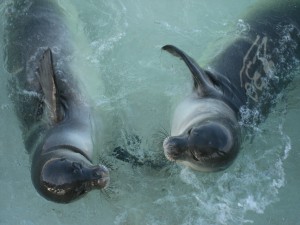Media Watch, Center for Biological Diversity, Press Release, 1 June 2011

The federal government has proposed to designate more than 11,000 square miles [28,000 sq km] of critical habitat for endangered Hawaiian monk seals. The proposed rule protects beaches and coastal waters on all the main Hawaiian Islands and expands protected habitat in the Northwestern Islands. The proposal responds to a 2008 petition filed by the Center for Biological Diversity, KAHEA: The Hawaiian-Environmental Alliance, and Ocean Conservancy. Hawaiian monk seals are among the most endangered marine mammals in the world, with a population of approximately 1,000 animals. The proposal will protect coastal areas for seals to raise pups and marine waters for foraging.
“New habitat protections, including all of the Hawaiian Islands, are essential to bring endangered Hawaiian monk seals back from the brink of extinction,” said Miyoko Sakashita, oceans director at the Center. “The proposal to protect Hawaii’s coastline for monk seals is a landmark decision that will benefit seals and the coastal environment for generations.”
The proposed rule expands the current critical habitat area for the Hawaiian monk seal in the Northwestern Hawaiian Islands to include deeper waters. It also designates new areas on all of the main Hawaiian Islands: Ni’ihau, Kaua’i, O’ahu, Moloka’i, Lāna’i, Kaho’olawe, Maui and Hawai’i. Areas protected would include coastal land up to five meters inland and waters out to 500 meters in depth, with certain exclusions.
Studies have shown that species with critical habitat are twice as likely to be recovering as species without it. The revised habitat protections are vital for monk seal survival because monk seals are dying of starvation, and populations of the seals on the Northwestern Hawaiian Islands are plummeting. Seal pups have only about a one-in-five chance of surviving to adulthood. In contrast, monk seals in the main Hawaiian Islands are in better condition and giving birth to healthy pups. Hawaiian monk seals are present on each of the main islands, and their numbers are slowly increasing. Thus the main islands are essential important habitat for the monk seals. Additionally, habitat in the main islands will provide a refuge for monk seals as important beaches where seal pups are born and raised have been lost due to sea-level rise and erosion.
“Critical habitat compels U.S. federal agencies to consider the survival of this Hawaiian seal before they permit shoreline development — protecting our beaches and reefs not only for monk seals, but also for Hawaii’s paddlers, fishers, surfers and all people of these islands,” said Miwa Tamanaha, executive director at KAHEA: The Hawaiian-Environmental Alliance.
Critical habitat designation will mean greater protection of Hawaiian monk seal habitat under the Endangered Species Act. Critical habitat protection does not close areas, but it does limit federal government activities that could harm monk seals or their habitat. Once designated, any federal activities that may affect the critical habitat must undergo review to ensure they will not destroy or damage that habitat. For example, habitat protections can help prevent pollution and require modification of construction activities to prevent destruction of the environment.
The proposed critical habitat designation for the Hawaiian monk seal is scheduled to be published in Thursday’s Federal Register. The National Marine Fisheries Service is accepting public comments on the proposal for 90 days.
For more information about Hawaiian monk seal critical habitat and how to comment on the critical habitat designation, go to: http://www.fpir.noaa.gov/PRD/prd_critical_habitat.html.
Source: New habitat protections proposed for endangered Hawaiian monk seals, Center for Biological Diversity, Press Release, 1 June 2011.
